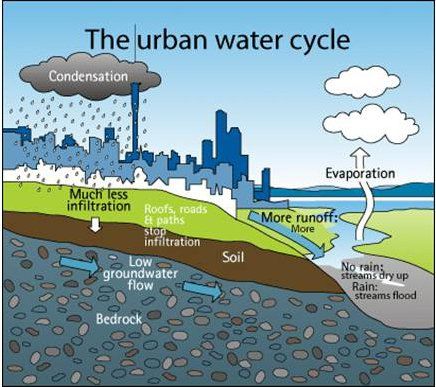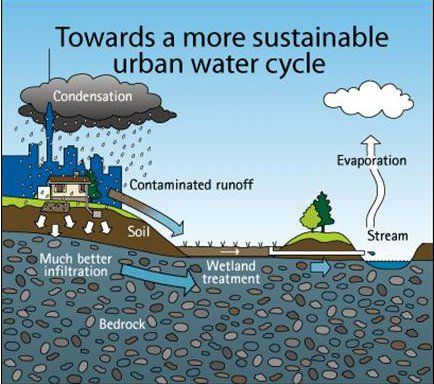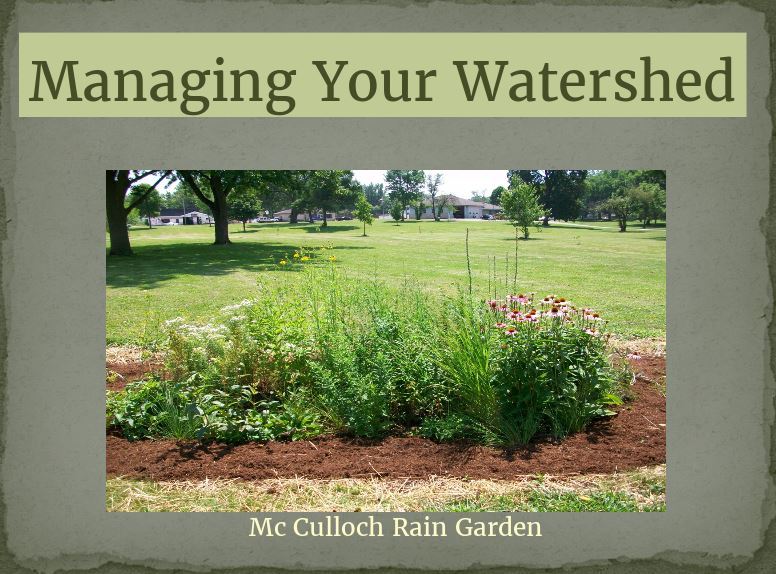Nonpoint Source Pollution
Today one of the leading threats to water resources and the quality of these resources is (NPS) Nonpoint source pollution. NPS pollution does not originate from a single, specific source (that would be Point Source Pollution) but is generated by a variety of activities spread over a broad area.
Everyone contributes to NPS pollution through many different daily activities. Driving an automobile, washing your car, mowing the grass, or walking a dog are just a few of the activities that can contribute to NPS pollution. Every time it rains, pollutants such as soil particles, pesticides, fertilizers, detergents, oil, grass clippings, litter, and animal waste are released into our waterways from plowed fields, parking lots, streets, rooftops, and neighborhood yards. The more we are aware of these potential NPS pollutants, the more measures we can take to prevent them from impacting the quality of our water in a negative manner.
→Awareness
Do you recognize any of these Non-Point Source Pollutants?
- Soil particles or sediments and other organic materials such as leaves and grass clippings can reduce water depth, smother aquatic organisms and reduce photosynthesis, which in turn decreases the amount of oxygen in the water. This leads to an unhealthy aquatic habitat which can negatively affect fish species, fresh-water mussels, macro-invertebrates, etc.
- Chemical nutrients in fertilizers, detergents, and sewage cause excessive plant growth and algae blooms. When broadcast spreading fertilizers on your lawn, make sure you sweep up any excess fertilizer that landed on your driveway or sidewalk back onto your lawn. If not, it will wash away during the next rain down to your local storm drain.
- Overgrowth of aquatic plants and algae can clog navigational waterways, impair recreational activities, block sunlight from penetrating the water column and reduce dissolved oxygen levels resulting in fish kills. High nutrient levels in the groundwater can also be a principal cause for closing potable wells and for methemoglobinemia (blue baby syndrome).
- Bacteria, waterborne viruses, and pathogens from septic systems, livestock and pets cause illnesses such as cryptosporidiosis that can result in the closure of swimming areas and shellfish beds.
- Toxins including heavy metals, pesticides, and organic chemicals from farms, lawns, city streets, driveways, and landfills can pose serious human health risks when they contaminate fish, shellfish, and drinking water wells. Leaves, grass clippings, twigs, and litter will also clog storm drains causing flooding on streets. Leaves and grass clippings not cleaned up will also create a nutrient-rich compost tea every time it rains which adds to nutrient levels in our waterways causing algal blooms.
- The threat of nonpoint source pollution is real. Every day thousands of pounds and millions of gallons of nonpoint source pollutants are entering and deteriorating our water resources throughout the United States. It has been reported (1) that:
- Each year, over 132 million gallons of used motor oil are poured down storm drains or disposed of in landfills nationwide.
→Solution:
Take your used motor oil to East Central Recycling (ECR) off Centennial Ave. during regular business hours, Mon-Fri 8 am to 5 pm, Sat. 8 am to Noon.
- Approximately 1,000 pounds of lead, zinc, cadmium and other toxic metals from streets and parking lots are introduced into receiving waters from a single rainstorm.
→Solution:
Check your vehicle frequently for leaks. If a leak has already occurred make sure you clean it up with some “quick dry” absorbent such as kitty litter, sweep it up and dispose of it properly in the trash.
- More than 70 million pounds of pesticides are used on lawns and golf courses annually.
→Solution:
Ask your Golf Course if they ever would consider “going green” and using fewer pesticides and fertilizers on their course. Encourage them to protect surrounding waterways by planting native plants and vegetation to help filter stormwater run-off.
- Approximately 80 million septic systems in the United States discharge 8 billion gallons of wastewater annually into soil and groundwater.
→Solution:
Have your septic tank inspected annually and have it pumped at least once every three years. Use caution in disposing of materials down the drain. Household chemicals can kill the bacteria that make the system work and non-degradable materials (cigarette butts, etc.) can clog the system.
Unfortunately, most people do not understand the threat of non-point source pollution to our water resources. They do not realize that everyday activities such as fertilizing the lawn and applying fertilizer minutes before a rainstorm can contribute to water pollution. Many people do not believe that their preventative actions can really make a difference, but they can! Once everyone figures out how they contribute to the problem and that they can be a part of the solution, the threat of nonpoint source pollution will decline.
(Information taken from, Implementing an Effective NPS Pollution Education Program)
The Water Cycle
This illustration depicts a “Natural Water Cycle” and shows how elements of nature work together to sustainably manage stormwater and rain.
This illustration depicts what happens to the natural “Water Cycle” once aspects of the urban environment (such as impervious surfaces including roofs, streets, and sidewalks) prevent stormwater infiltration from recharging our groundwater.

This illustration depicts a more “Sustainable Urban Water Cycle” that has strategically re-introduced natural elements (such as a Wetland and Riparian Buffer) to help filter stormwater run-off before entering local waterways.

(Source: http://www.clemson.edu/public/carolinaclear/water_quality/)
→2nd Step: Prevention
Managing Your Watershed

Click here for a slideshow presentation about Stormwater and Watershed Management!
→ 3rd Step: Spread the Word!
Citizens are the eyes and ears of the community. Now that you are aware of what can harm our water quality you also have the ability to educate your local neighborhood association, friends, family, businesses, etc. Encourage your neighborhood to consider a “Neighborhood Watershed Program” encouraging everyone to utilize resident best management practices such as rain barrels, rain gardens, illegal downspout disconnections, composting, and planting native plants.
Report suspicious actions such as dumping anything other than rain into our storm drains, pipes directly going into the river, culverts releasing liquids during non-rain events, large amounts of sediment erosion onto a street or waterway, illegal dumping, etc. You may report such actions anonymously by calling the Stormwater Management Department at 765-747-4896.
→ Next Step: Get Involved!
For more info or to schedule an educational workshop contact:
Laura Bowley
MS4 Coordinator
765-747-4896
“NEED TO KNOW” DEFINITIONS
Impervious – The characteristic of a material which prevents the infiltration or passage of liquid through it. This may apply to roads, streets, parking lots, rooftops, and sidewalks.
Nonpoint Source Pollution – Nonpoint source (NPS) pollution, unlike pollution from industrial and sewage treatment plants, comes from many diffuse sources. NPS pollution is caused by rainfall or snowmelt moving over and through the ground. As the runoff moves, it picks up and carries away natural and human-made pollutants, finally depositing them into lakes, rivers, wetlands, coastal waters, and even our underground sources of drinking water
Combined Sewer Overflows (CSO) – Excess flow (combined wastewater and stormwater runoff) discharged to a receiving water from a combined sewer network when the capacity of the sewer network and/or treatment plant is exceeded, typically during storm events.
Bio Swale/Bio Filter – Grass depression areas such as engineered channels or swales that are used to collect and filter urban stormwater. This term was developed in the Pacific Northwest.
Riparian Buffer – The land area which borders a stream or river and which directly affects and is affected by the water quality. This land area often coincides with the maximum water surface elevation of the 100-year storm.
Wetland – Those areas that are inundated or saturated by surface or groundwater at a frequency and duration sufficient to support, and that under normal circumstances do support a prevalence of vegetation typically adapted for life in saturated soil conditions. Wetlands generally include swamps, marshes, bogs, and similar areas.
Literature Cited
1. The National Geographic Society. The Conservation Fund. Undated. Water: Taking A New Track on Nonpoint Source Pollution. Terrene Institute. Washington, D.C.
Other Sources Cited
Information is taken from, Implementing an Effective NPS Pollution Education Program (p. 1-2). MRI, Florida Community College (Consortium for Pollution Prevention Education), Department of Environmental Protection Florida, Environmental Protection Agency.
